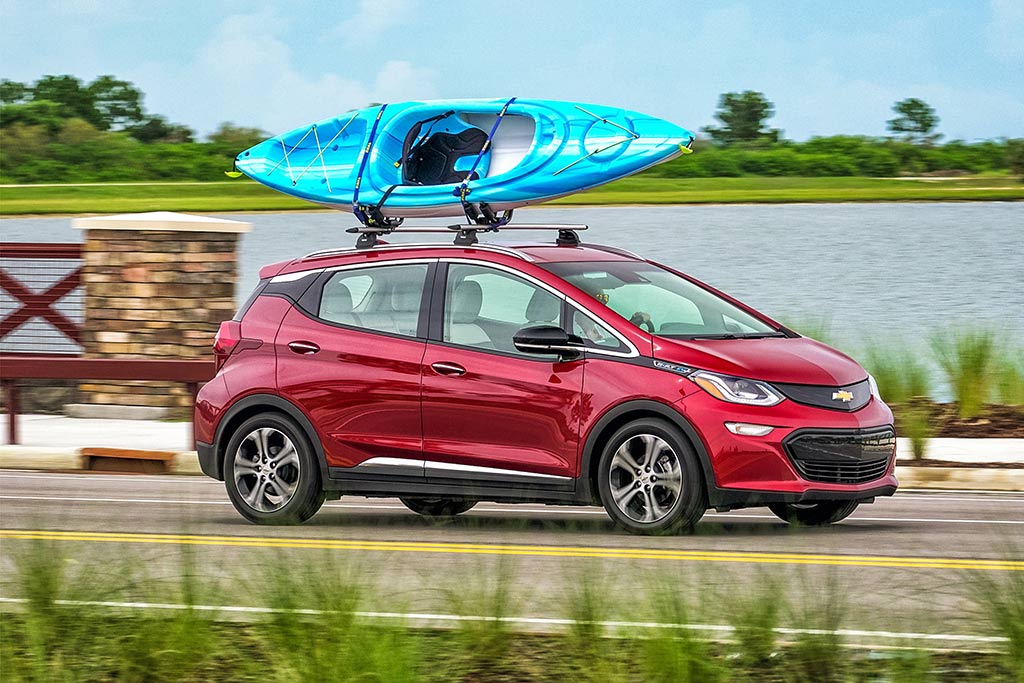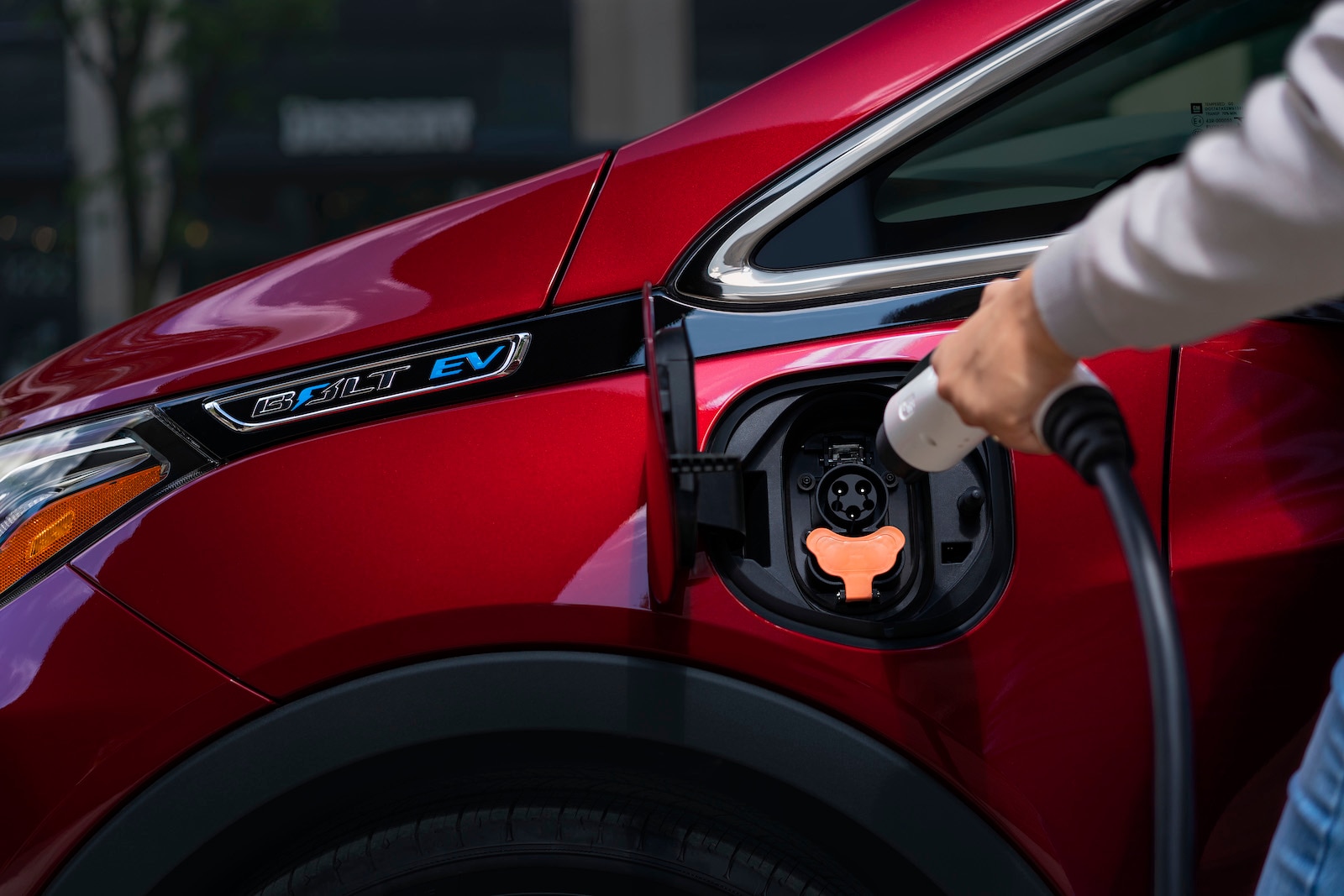The 2021 Chevrolet Bolt EV is an all-electric subcompact hatchback at the sharp end of an automotive revolution. Although we have this car, Tesla cars, and all-electric vehicles from Audi, Jaguar, Mercedes-Benz (the new EQC), Kia, and Hyundai, battery power is still at the niche level compared with all those gasoline-powered vehicles out there.
With an average full recharge time of nine hours (at a 240-volt outlet) or a little under two hours using a DC fast charger, the Bolt EV isn’t wildly convenient. But it is more environmentally friendly, cheaper to run, and arguably hipper than a fossil-fuelled vehicle.
Like the BMW i3, the Bolt EV is distinct and fun. And by being able to cover 259 miles from a full charge, it can travel further solely on electric power than even a range-extended i3.
The Bolt EV no longer qualifies for a federal tax credit, due to Chevrolet reaching the government’s 200,000 electric vehicle limit. There may be further savings offered at the state level and by General Motors to keep the Bolt EV’s price competitive.
Compared with electric offerings from premium marques, the 2021 Bolt EV is far more affordable. Yet it’s still pricier than the Kia Niro EV, Nissan Leaf and Hyundai Kona EV. But its range is much greater than the first two. Since the Hyundai Kona EV’s range is 258 miles, we’ll call that one a real-world tie.
What’s New for 2021?
Premier trim gains DC fast charging as standard. See the 2021 Chevrolet Bolt EV models for sale near you
What We Like
- Relatively roomy interior
- 259-mile range on a single charge
- Available in all 50 states
What We Don’t
- Charging times still long
- No backup motor/generator option
- Drab interior colors
- Lacking some driver aids like adaptive cruise control and high-speed automatic emergency braking
How Much?
$37,495–$42,695
Fuel Economy
As the Chevy Bolt EV is a completely electric car, fuel economy is measured in miles per unit of electrical energy, not per gallon of gasoline. It’s what the Environmental Protection Agency (EPA) calls a miles-per-gallon equivalent (MPGe).
The EPA puts 2021 Bolt efficiency at 127 MPGe in the city, 108 MPGe on the highway, and 118 MPGe in combined driving. Maximum range is 259 miles.
This is all accomplished by an electric motor developing 200 horsepower and 266 lb-ft of torque, the latter available almost all at once. Drive goes solely to the front wheels. Electricity is stored in a 60-kilowatt lithium-ion battery pack.
Standard Features and Options
The 2021 Chevrolet Bolt EV comes in LT and Premier trim levels.
LT ($37,495) has 17-in alloy wheels with self-sealing tires, automatic on/off HID headlights, remote entry/start, heated/power-adjustable side mirrors, power locks/windows, cruise control, single-zone automatic climate control, external sound generator (to warn pedestrians), 8-in driver information display, a steering wheel that adjusts for height and reach, programmable Teen Driver key, 10.2-in color infotainment touchscreen, two USB ports, OnStar with 4G LTE Wi-Fi, Apple CarPlay/Android Auto smartphone integration, satellite radio, Bluetooth, and a 6-speaker audio system.
The LT’s main options are bundled into packages. A Comfort and Convenience Package brings a self-dimming rearview mirror, heated front seats, and a leather-wrapped/heated steering wheel. The Driver Confidence Package includes blind-spot monitoring with rear cross-traffic alert and rear parking sensors.
Premier ($42,695) has those extras in the Comfort and Convenience and Driver Confidence packages as standard, adding Normal and Sport driving modes, leather seating surfaces, upgraded 17-in alloy wheels, roof rails, 360-degree camera system, rear camera mirror, ambient cabin lighting, heated rear outboard seats, a rear-seat armrest, and DC fast charging.
Premier trim is also eligible for an Infotainment Package that adds a 7-speaker Bose audio system, wireless charging, and two USB charging ports for rear passengers.
Both trims qualify for the Driver Confidence II Package to acquire forward collision warning with low-speed automatic braking and pedestrian detection, lane departure warning/lane-keeping assistance, following distance indicator, and automatic high beams. This package is not too expensive ($495), but these features are standard in more affordable rivals.
The 2021 Bolt EV comes with a 3-year/36,000-mile basic warranty, a 5-year/60,000-mile powertrain warranty, and an 8-year/100,000-mile warranty covering the battery pack, thermal management system, charging system, and various electric drivetrain components.
Safety
Every 2021 Bolt EV comes with 10 airbags as standard, including side curtain airbags, front knee airbags, and front-side airbags. There’s also a rearview camera and GM’s OnStar telematics system.
In crash testing carried out by the National Highway Traffic Safety Administration (NHTSA), the Bolt EV earned five stars overall. The Insurance Institute for Highway Safety (IIHS) gave the Bolt EV its highest rating of Good in most major categories, except for the small overlap front passenger-side crash test, which resulted in an Acceptable rating.
Behind the Wheel
Driving the Bolt EV is unremarkable. Which is a compliment. There are no surprises, no great learning curve to accompany a different method of propulsion.
There’s no engine noise, either (there’s no engine), so road and wind noise might be more noticeable than in a gasoline-engined car. But it’s mostly a case of getting in the Bolt EV and driving. Chevy claims acceleration from standstill to 60 mph in 6.5 seconds, which is pretty quick for a subcompact hatchback.
The electrically assisted power steering is responsive and has some feel, with a light weight at low speeds and more heft at higher speeds. The car’s low center of gravity (thanks to the placement of the 1,000-pound battery pack below the floor) brings stability through the curves. It’s even possible to have a little fun on a winding road. The Bolt EV offers levels of engagement that drivers can get into or not — as their personalities, tastes and whims dictate.
The Bolt EV’s 259-mile range seems feasible since there are two regenerative on-board recharging systems. The first is common in all hybrid and electric cars, capturing energy generated under braking.
The second, Regen on Demand, uses a steering-wheel-mounted paddle that allows the driver to initiate regeneration without ever touching the brake pedal. This concept is similar to downshifting with a manual transmission, using engine braking to slow the vehicle.
If you’re into the gaming aspect of EVs, you can interact with the car to maximize range — it provides feedback in the instrument panel. Or you can ignore that, and just pay attention to the state of charge and range as a driver would with a regular fuel gauge.
The Bolt’s interior is simple and familiar rather than jarringly modern, with a somewhat raised driving position created by the battery pack’s location. The most prominent cabin feature is the big 10.2-inch touchscreen at the top of the center stack. It’s rectangular and in landscape orientation. The center console is low and open, which makes the cabin feel relatively airy. Soft-touch plastics are in the right places and build quality appears solid.
Other Cars to Consider
2021 BMW i3 — The BMW i3 has rather radical styling (inside and out), isn’t as roomy as the Bolt EV, and range isn’t as long. But it does offer an optional onboard gasoline generator that extends its range to about 180 miles.
2021 Nissan Leaf — The Leaf offers a 62-kWh battery that pushes maximum range to 226 miles. The base Leaf S costs nearly $7,000 less than the Bolt EV LT, but is not as well-equipped, nor can it go as far.
2021 Hyundai Kona EV — The excellent Kona EV subcompact crossover is the Bolt EV’s closest competitor with similar pricing, size, and range.
Used Tesla Model 3 — Pricier than the Bolt EV, but a used Tesla Model 3 will have a longer range, greater interior space, and cooler features like autonomous driving and all-wheel drive.
Questions You May Ask
Why doesn’t the 2021 Chevrolet Bolt EV get a federal tax credit?
The federal tax credit only applies to alternative-fuelled cars that have sold fewer than 200,000 units. So the Bolt EV is kind of a victim of its own success. It’s the same situation with Tesla cars. The credit used to be $7,500 and went down to $1,875 for 2020. There might still be some state incentives.
Is the Chevrolet Bolt EV all-electric?
Yes. Utterly and completely. No gasoline engine anywhere, not even to act as an on-board generator. The Bolt EV has an electric motor energized by a rechargeable lithium-ion battery pack. Its maximum range is an impressive 259 miles. But don’t plan a 250-mile trip without factoring in at least one charging station, just to play it safe.
Is Chevrolet going to keep making the Bolt EV?
Yes. An all-new generation of Bolt EV is coming for the 2022 model year. What has ceased production is the similar-sounding Chevrolet Volt, a plug-in hybrid (PHEV) with a supplementary gasoline engine. It was discontinued after the 2019 model year. A Bolt-based small crossover, the Bolt EUV, is also due in 2022.
Autotrader’s Advice
Range is the same with either trim, so the LT’s low entry price with the two Driver Confidence Packages makes a nicely equipped electric car for the money. Find a Chevrolet Bolt EV for sale
























